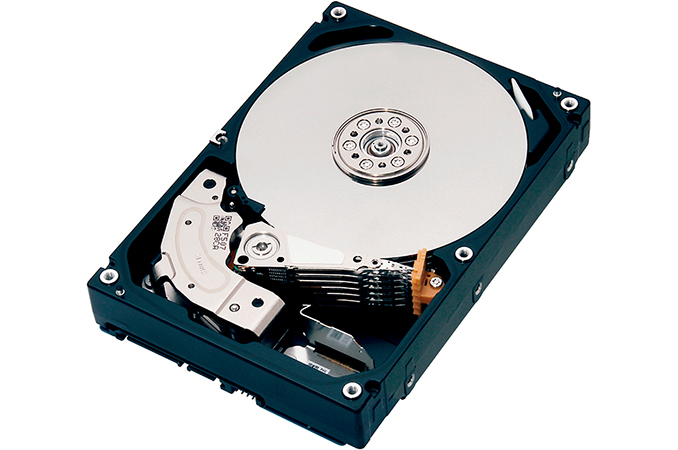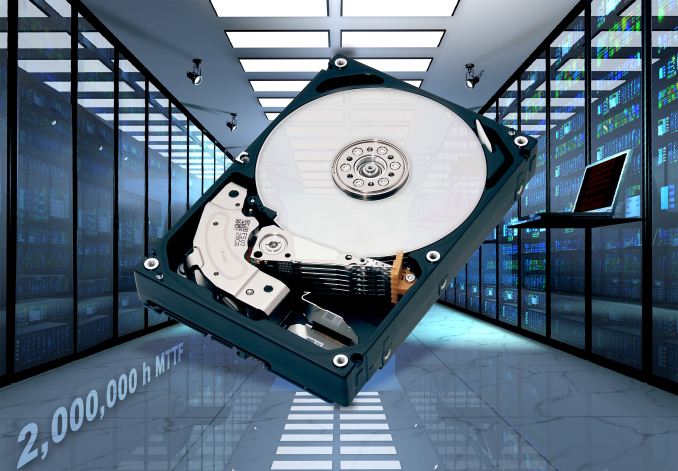Toshiba Launches MG05ACA Enterprise HDDs: 8 TB, 7200 RPM, NAND Cache
by Anton Shilov on April 10, 2017 2:00 PM EST
Toshiba recently introduced its new generation of enterprise-class nearline HDDs for servers, surveillance, and higher-end NAS systems. The new MG05ACA-series hard drives offer up to 8 TB of capacity and 12% higher performance than their direct predecessors, but one of their key selling points is Toshiba’s NAND flash-based cache technology for data protection in case of power-loss events that was originally designed for mission-critical HDDs.
Toshiba’s MG05ACA-series HDDs are currently available only in 8 TB configurations and are based on multiple PMR (perpendicular magnetic recording) platters with either 4Kn or 512e sectors. The hard drives use a SATA 6 Gbps interface, feature a 7200 RPM spindle speed, a 128 MB cache buffer, and Toshiba’s persistent write cache (PWC) with power loss protection (PLP) that stores data that is not yet written to the HDD media. When it comes to performance, Toshiba declares up to 230 MB/s sustained host to media transfer speed as well as 4.17 ms average latency. As for power consumption, the MG05ACA-series hard drives are rated to consume up to 11.4 W during random reads and 6.2 W in active idle mode.
The Toshiba MG05-series HDDs are designed for nearline applications (i.e. somewhere between rapid access and cold storage) that operate for 24/7. The model is rated for 550 TB/year annual workload (read and write) as well as for 2 million hours MTBF. Typ enterprise-class hard drives are based on special platforms with improved endurance prone to operate under high vibration conditions (i.e., in rack servers) due to rotational vibration compensation technology as well as special spindle mounting mechanism.
| Toshiba MG05ACA-Series HDDs | |||||
| MG05ACA800A | MG05ACA800E | ||||
| Capacity | 8 TB | ||||
| RPM | 7200 RPM | ||||
| Interface | SATA 6 Gbps | ||||
| DRAM Cache | 128 MB | ||||
| Data Transfer Speed (Sustained) |
230 MB/s | ||||
| Average Latency | 4.17 ms | ||||
| Sectors | 4 KB native | 512 B emulated | |||
| MTBF | 2 million hours | ||||
| Rated Annual Workload (read and write) | 550 TB/year | ||||
| Power | Operating (read) | 11.4 W | |||
| Active Idle | 6.2 W | ||||
| Warranty | 5 years | ||||
The performance of the drives (and their positioning) indicates that we are dealing with PMR-based products, but Toshiba remains tight-lipped regarding the exact number and capacity (areal density) of the platters it uses. The only photo of the MG05ACA HDD that Toshiba has published depicts a hard drive with seven arms and six platters, but press images are not always accurate. Meanwhile, power consumption of the HDDs (well over 10 W) indicates that we see a typical air-filled HDD. Apparently, Toshiba plans to first use SMR (shingled magnetic recording) and helium for read-oriented drives designed for cold archives and only then use the latter helium drives for its enterprise-capacity HDDs. At this point not using helium puts Toshiba in a tough position as it has nothing to compete against 10 TB and 12 TB drives from its rivals.
It is noteworthy that Toshiba’s MG05-series HDDs are the company’s second-gen 3.5” nearline hard drives to feature its persistent write cache with power loss protection technology. The manufacturer does not disclose capacity of the NAND flash-based cache, but it does not have to be too high. There are several situations when the PWC with PLP comes into play, with the main one being when the HDD write cache contains data not yet written to media and a power loss occurs, the data is moved to non-volatile memory.
Toshiba's MG05ACA800A and MG05ACA800E are available to the company's customers now. We expect the MG05 lineup will over time be expanded with models featuring lower capacity as well as with versions that use the SAS 12 Gb/s interface. All the Toshiba MG-series drives are covered by the company’s five-year warranty.
Related Reading:
Source: Toshiba











10 Comments
View All Comments
DanNeely - Monday, April 10, 2017 - link
"There are several situations when the PWC with PLP comes into play, with the main one being when the HDD write cache contains data not yet written to media and a power loss occurs, the data is moved to non-volatile memory."Does this mean than instead of streaming writes though the flash cache, writes normally go directly from the dram buffer to the platters and the flash cache is only invoked in the event of a loss of external power (and presumably powered by on board capacitors).
MrSpadge - Monday, April 10, 2017 - link
Very probably. Otherwise I don't see how they would achieve 550 TB/year over 5 years without significant cost.ZeDestructor - Monday, April 10, 2017 - link
Back EMF, not capacitors - basically uses the HDD motor and platter inertia during the deceleration to generate the power needed to flush the DRAM to NAND.leexgx - Thursday, April 20, 2017 - link
its the 128MB of cache that it has is the NANDScott_T - Monday, April 10, 2017 - link
I'm liking the return of warrantys longer than a year. Makes me a bit more confident using these humongous drives.BrokenCrayons - Monday, April 10, 2017 - link
Since this drive is targeted at enterprise customers, the warranty period is fairly standard. Corporate customers are usually more demanding about support after the sale than consumers, after all.DanNeely - Monday, April 10, 2017 - link
enterprise customers also generally follow through with demands for a longer warranty period vs the typical consumer that grumbles about crappy default options, but who then buys the absolute cheapest product in a category anywhere even though its warranty ends when the picker in the warehouse takes it off the shelf.MrSpadge - Monday, April 10, 2017 - link
With it being an Enterprise grade drive expect it to cost about twice as much as an equivalent consumer drive with lower warrenty.ajp_anton - Tuesday, April 11, 2017 - link
Why is the "average latency" at all worth mentioning? It's just the time for half a rotation, (1 / (7200/60)) / 2 = 0.00417, and is only a fixed part of the access time. And it's the same fixed time for all 7200rpm HDDs.creed3020 - Wednesday, April 12, 2017 - link
Why is there no mention of the NAND cache that these drives are supposedly equipped with? I understand that it is for data in flight protection but nothing more, this sounds like a standout feature but its given no more than a sentence of coverage....what gives?